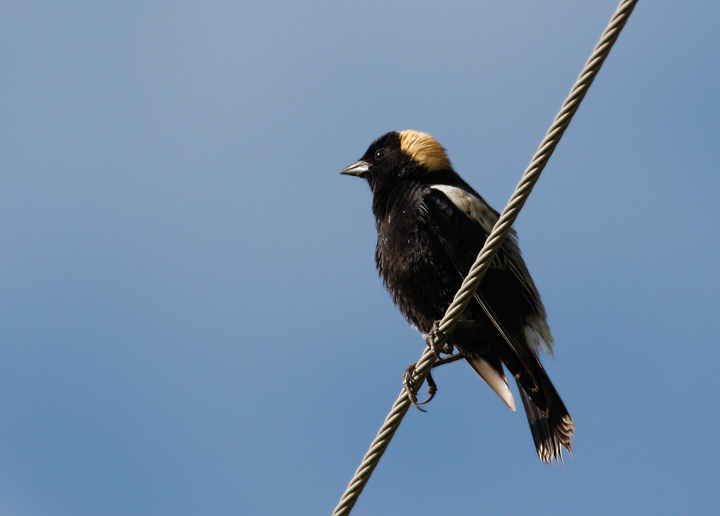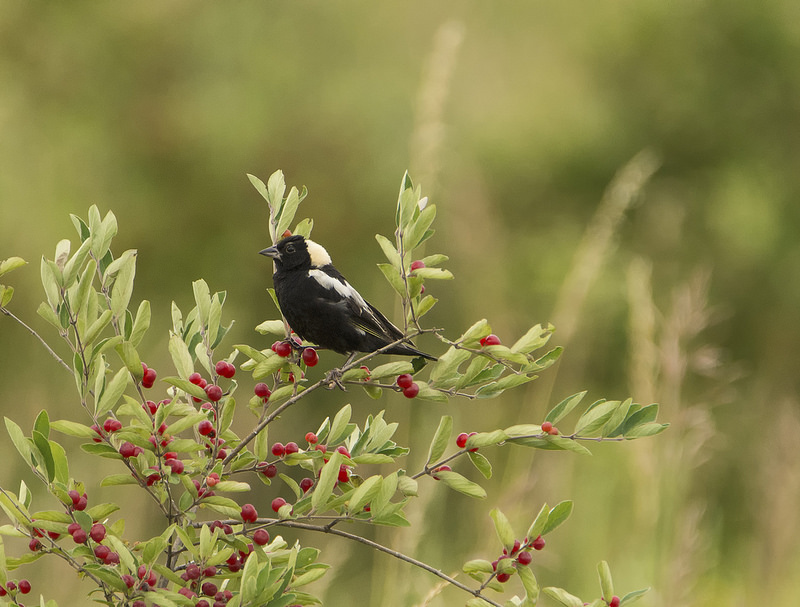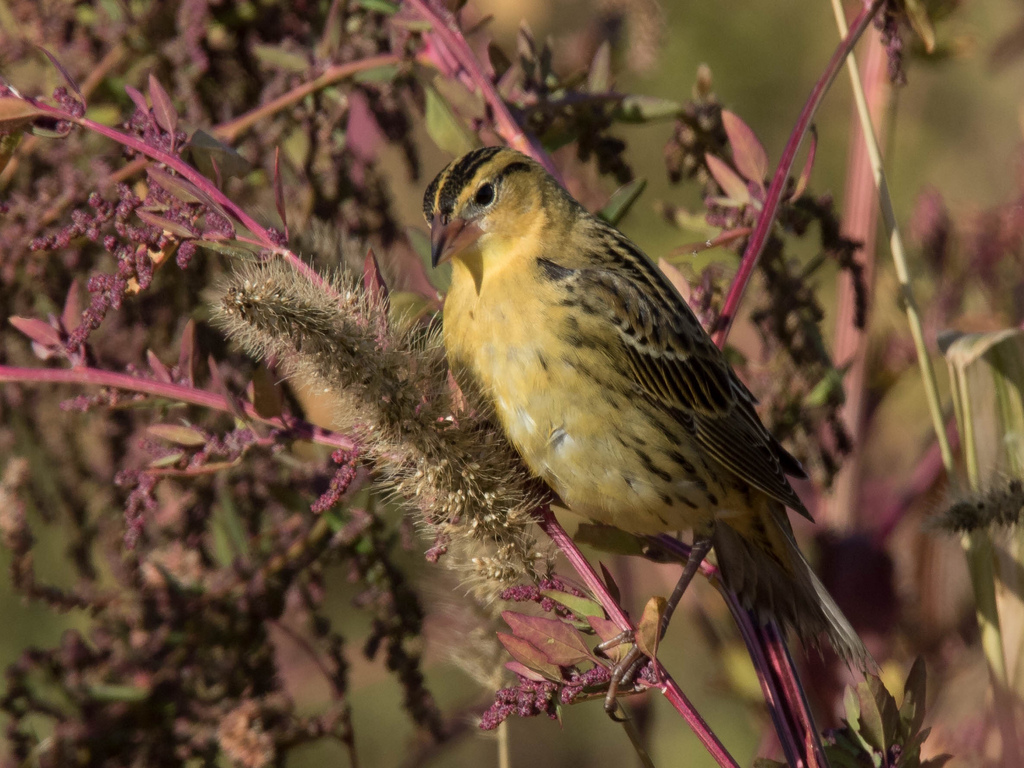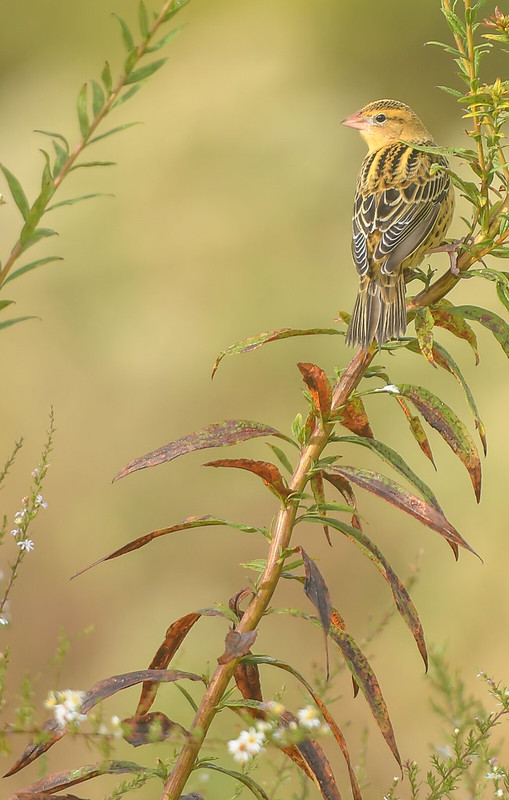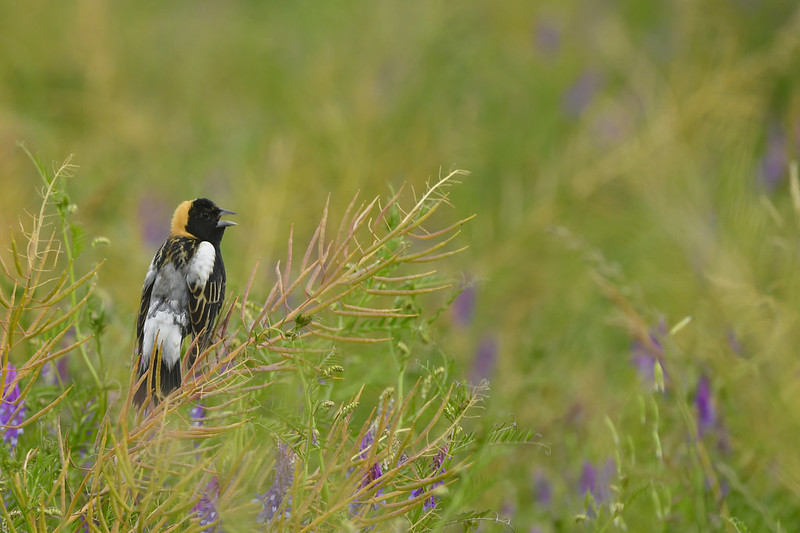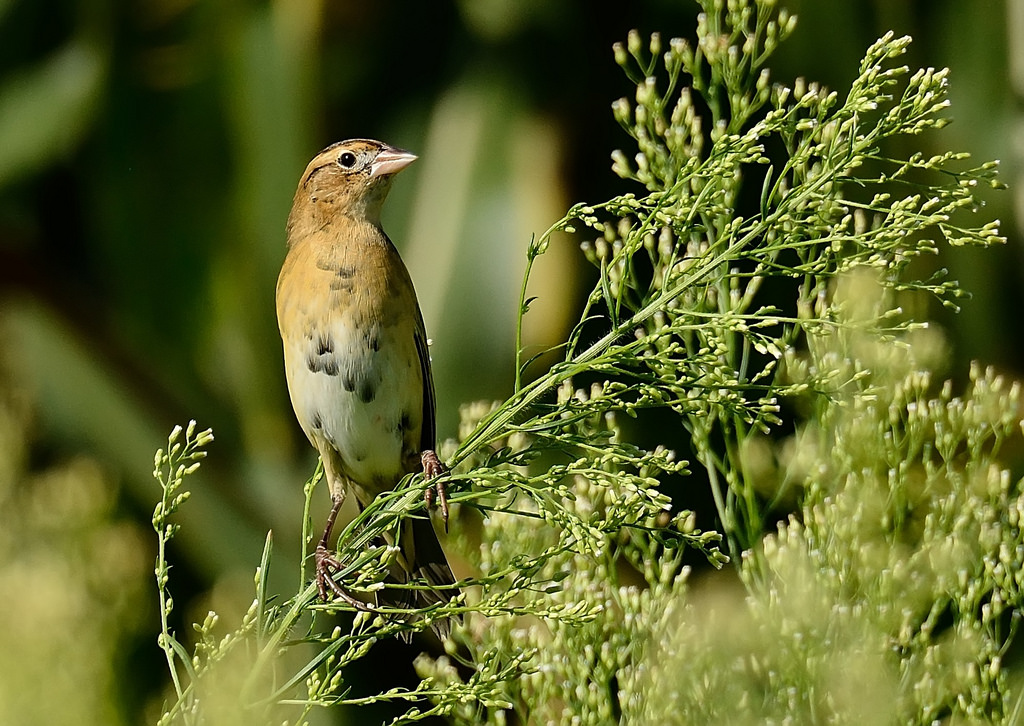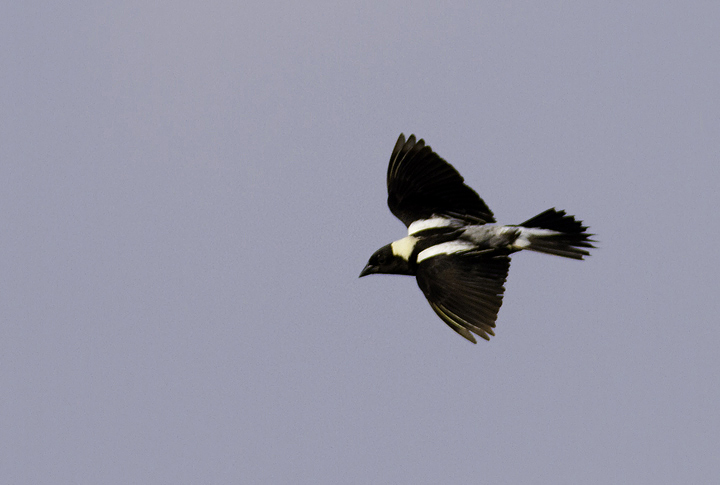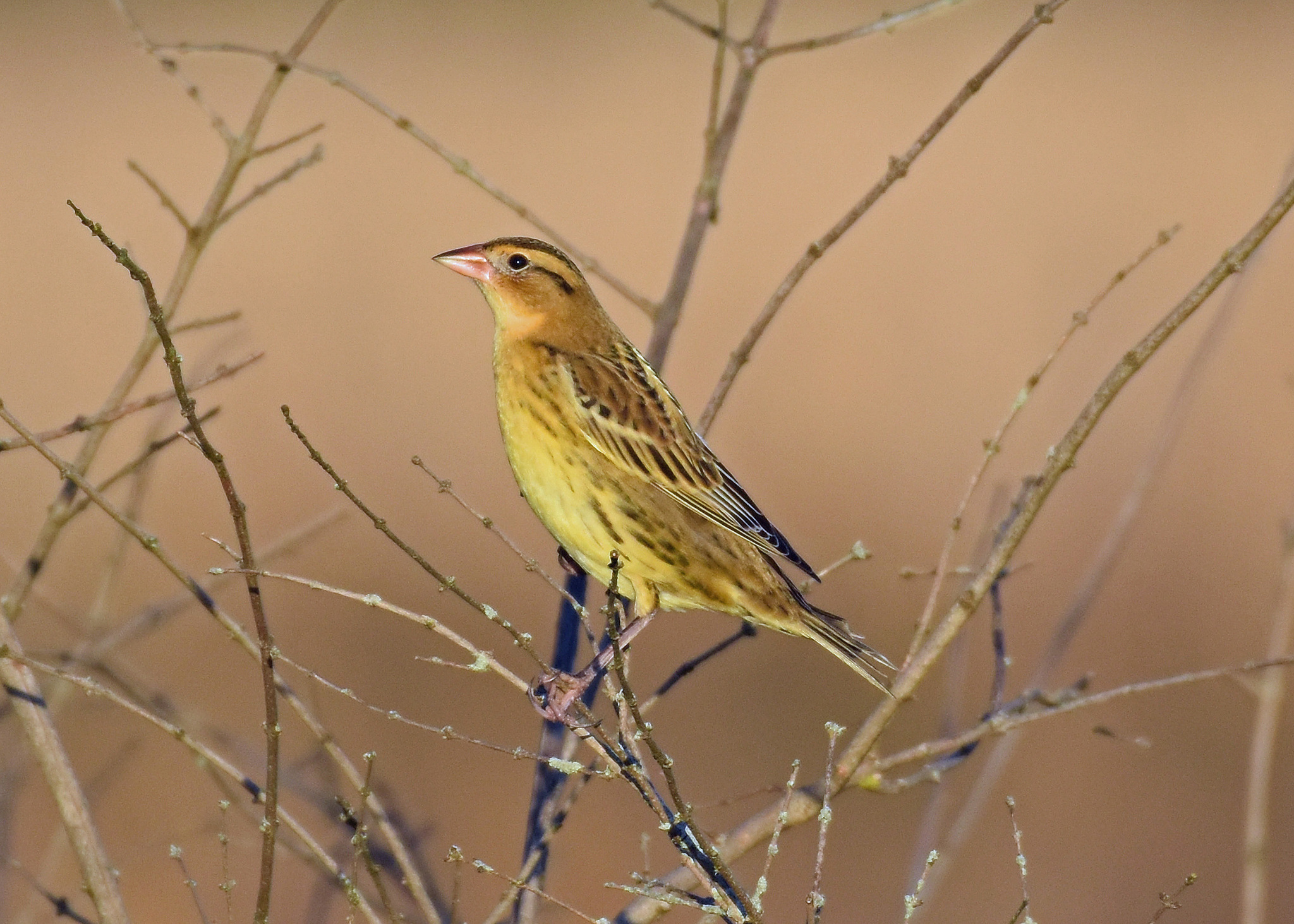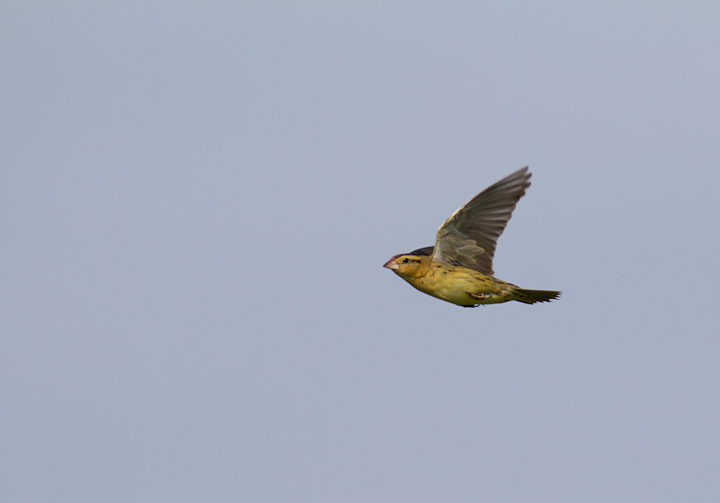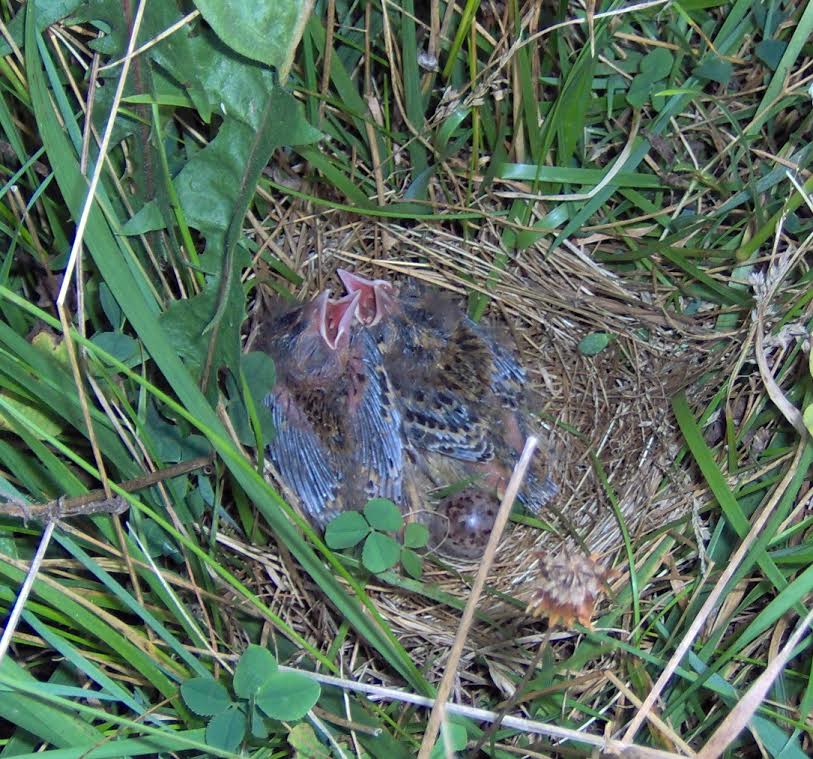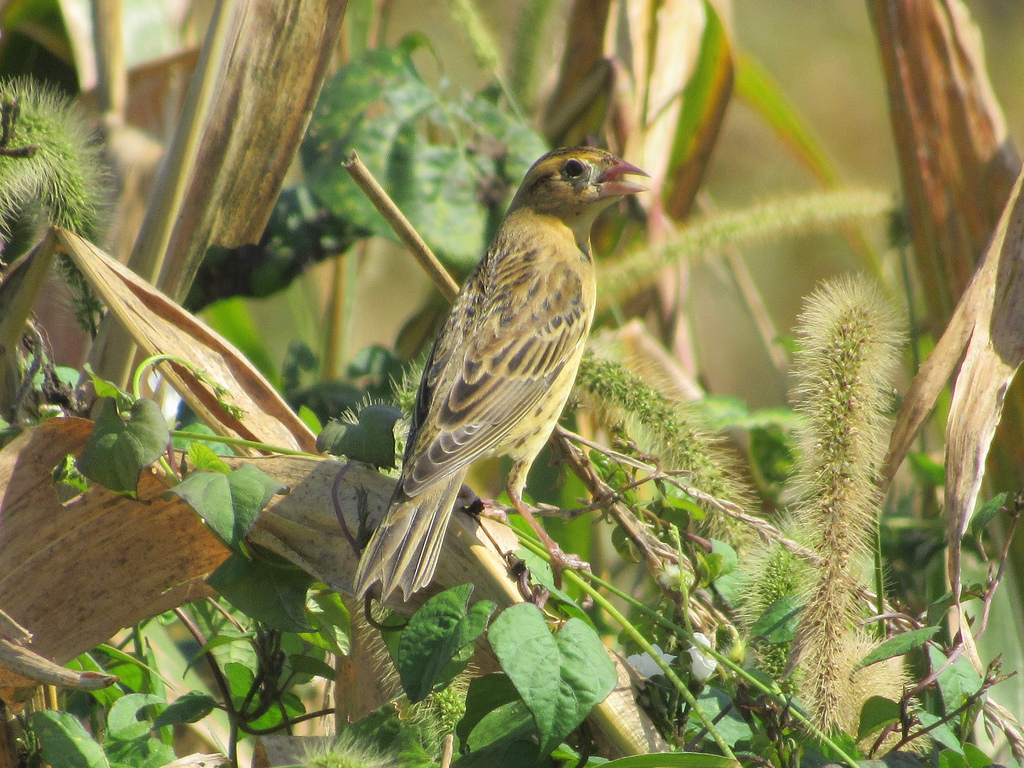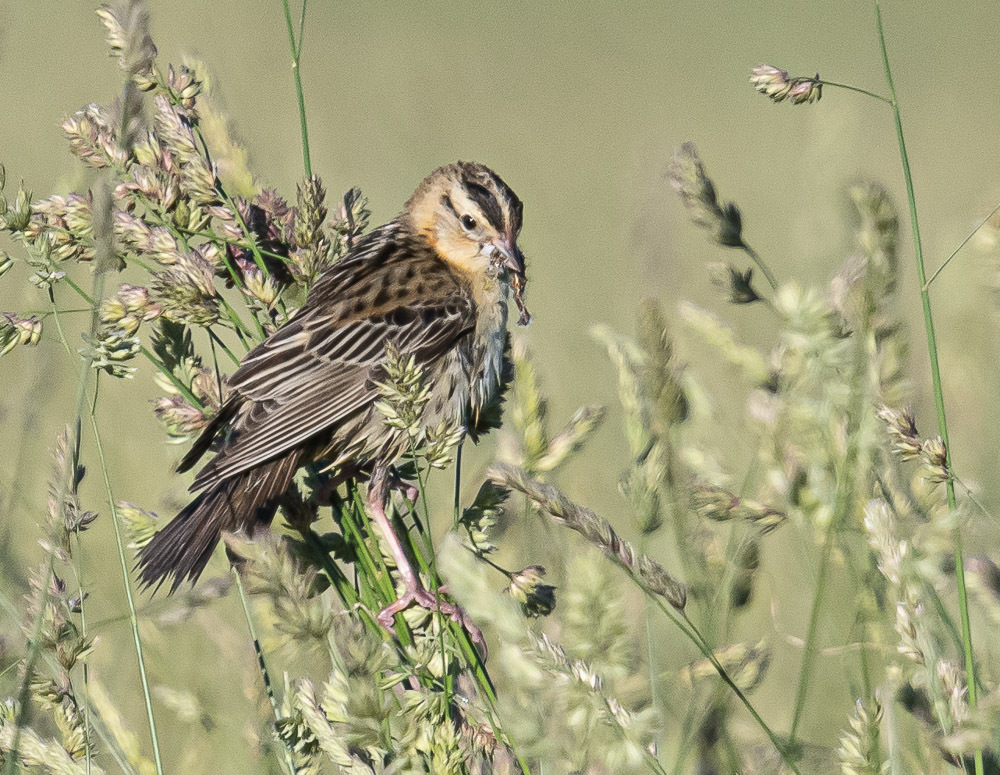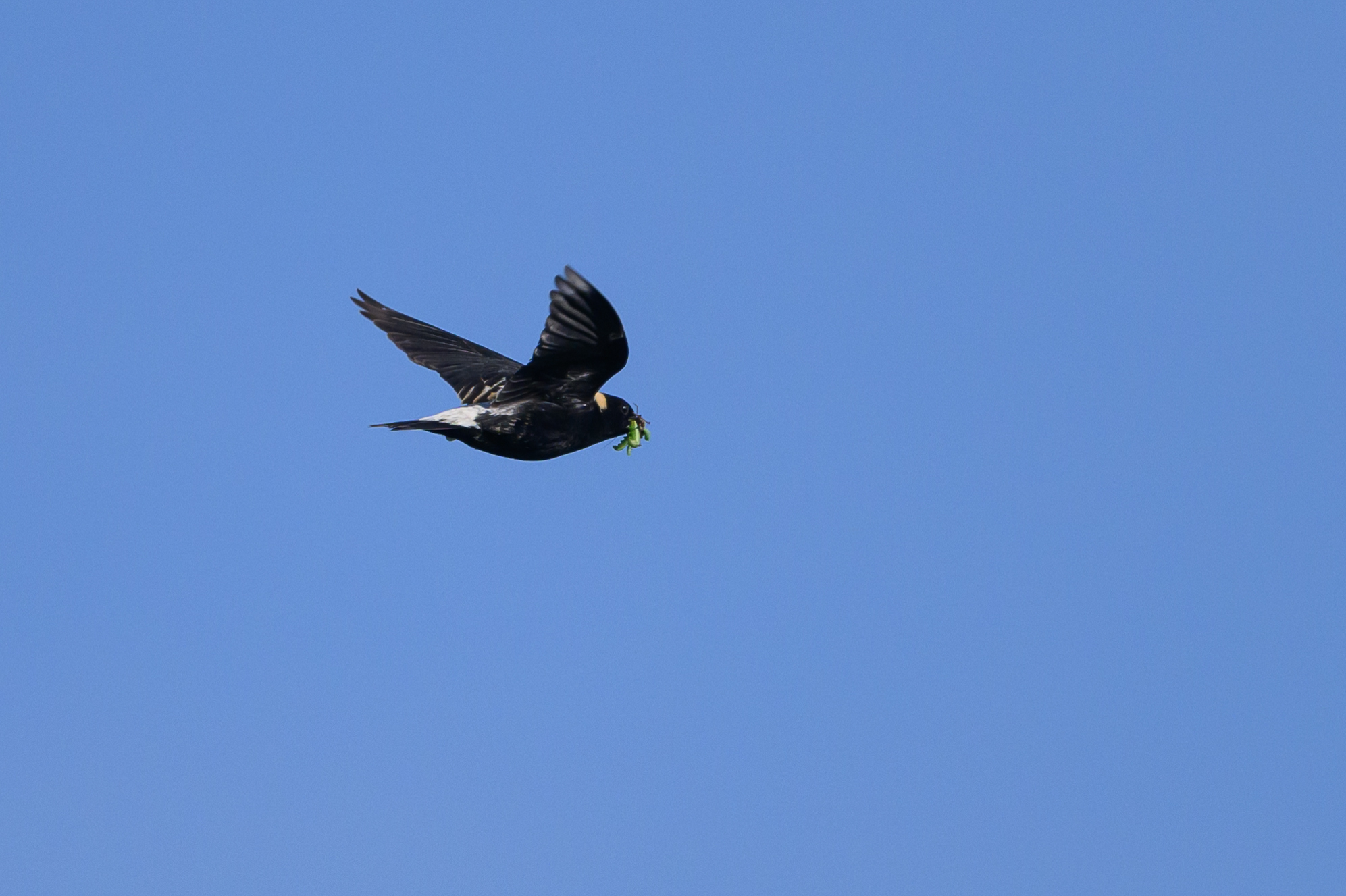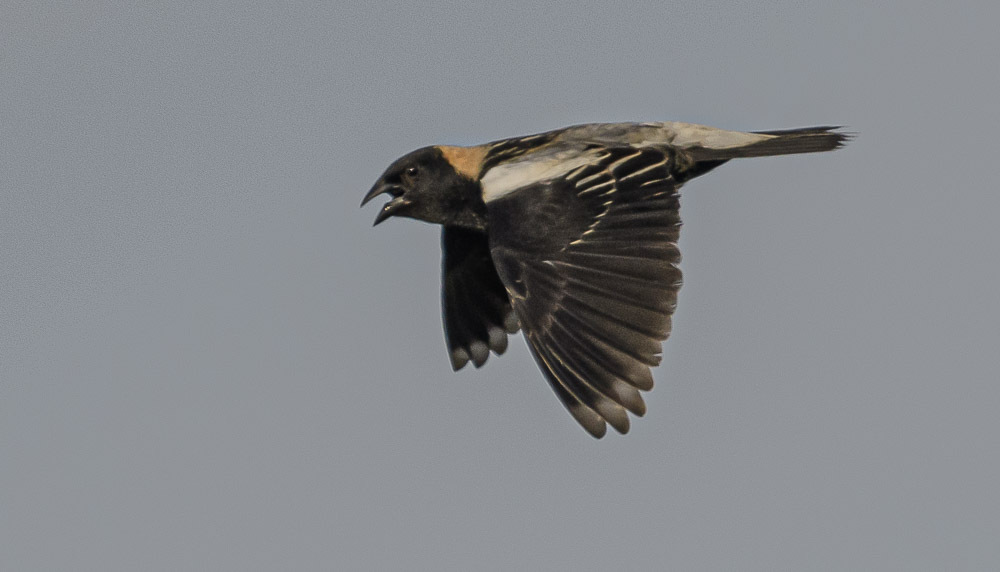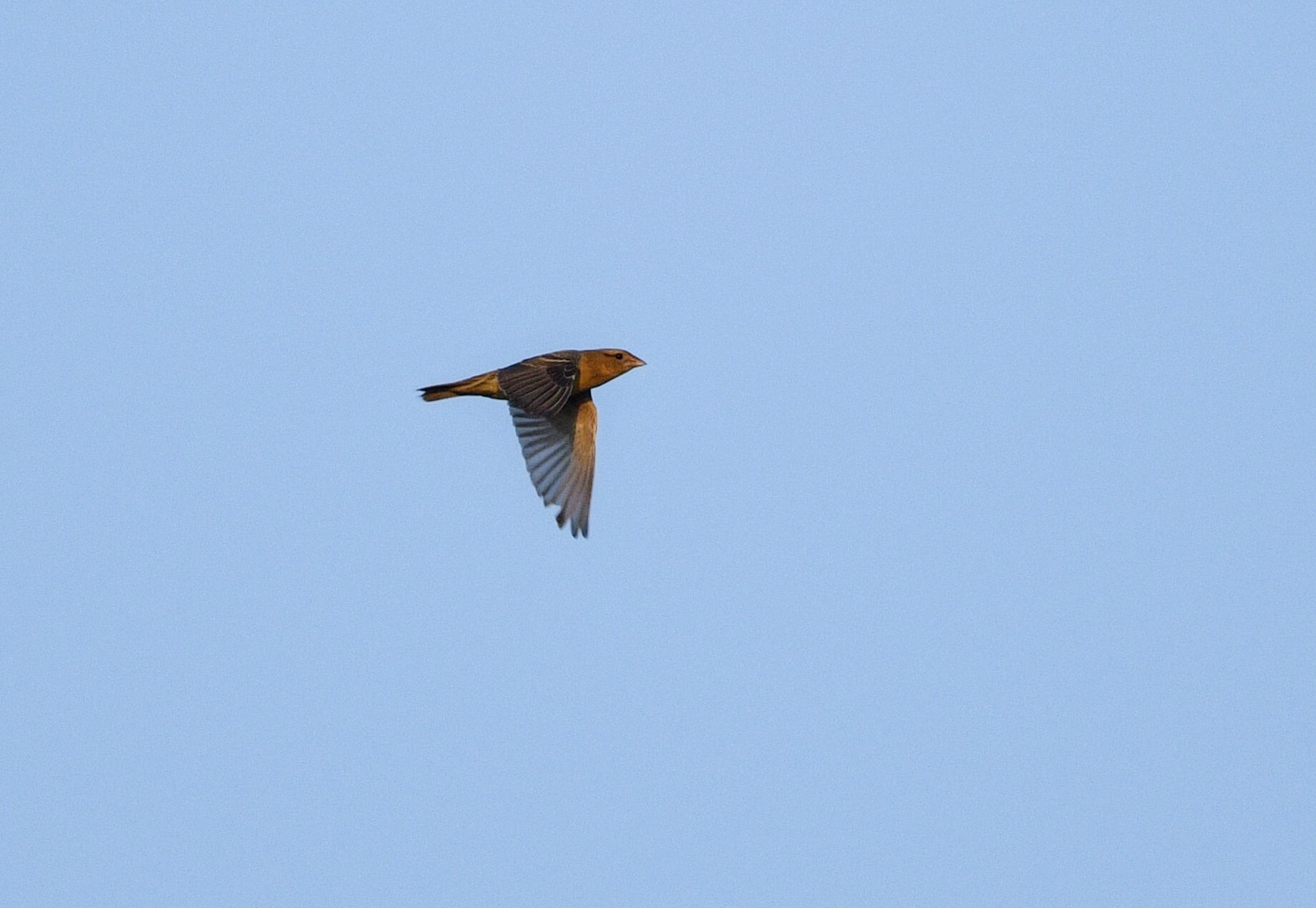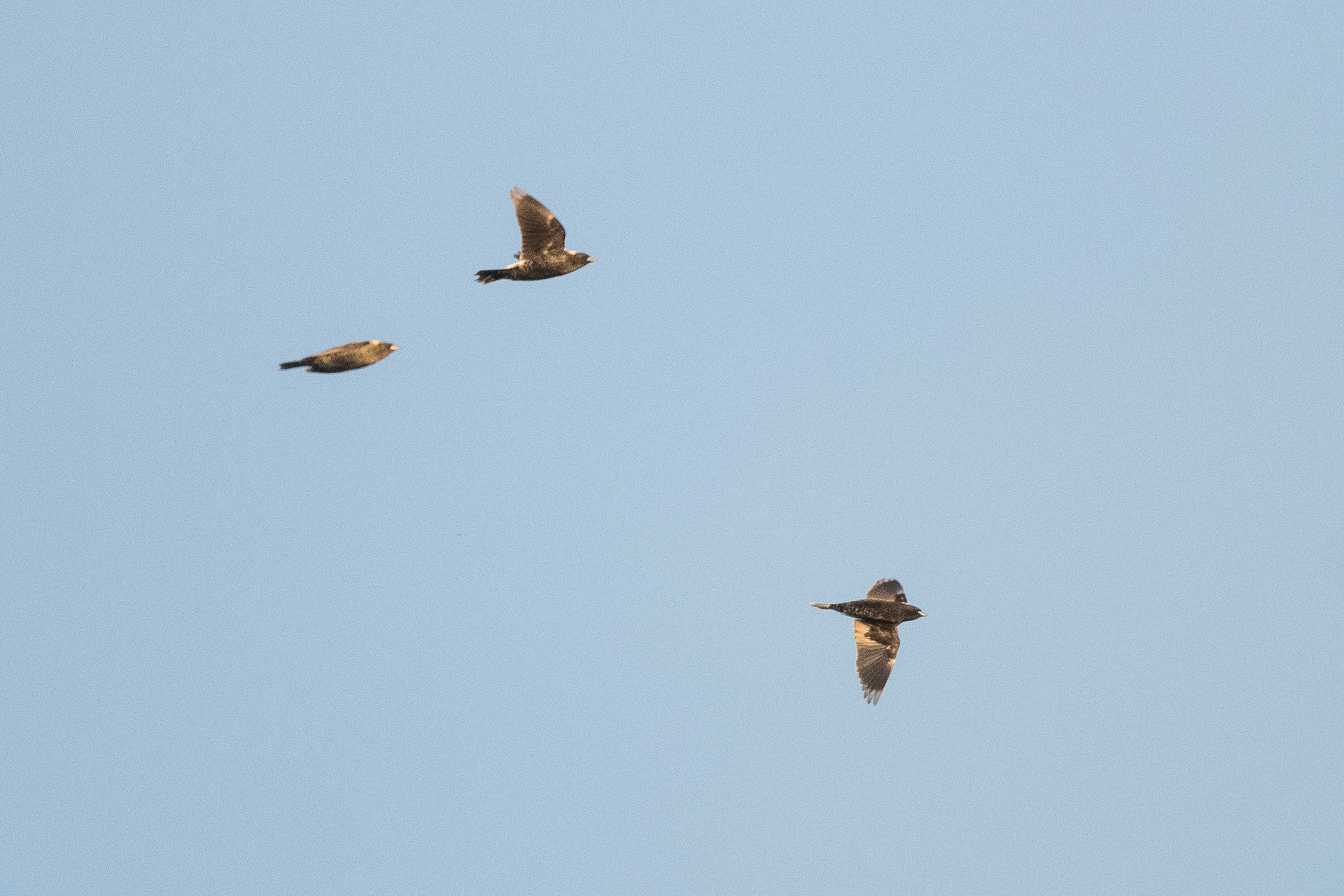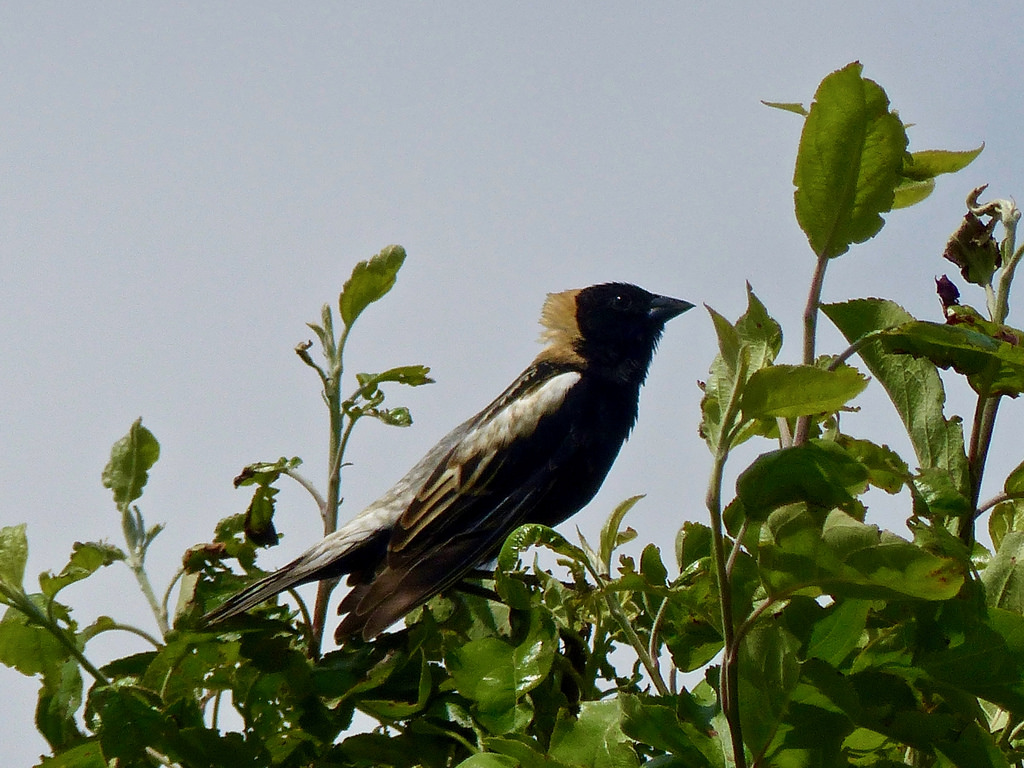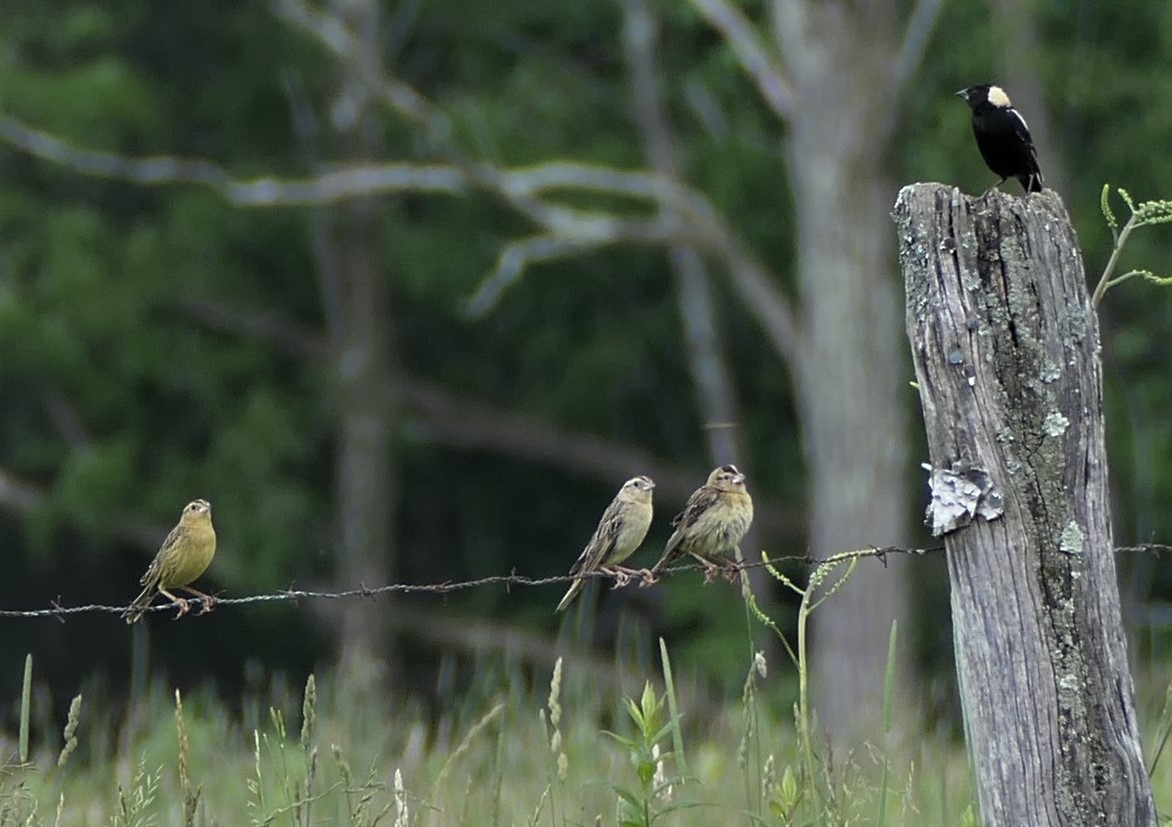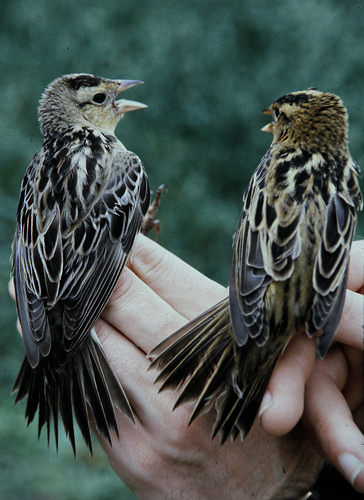Map Snapshot

























353 Records
Bobolink in Queen Anne's Co., Maryland (4/29/2023). (c) dansmall, some rights reserved (CC BY-NC). - Dan Small.
Bobolink in Garrett Co., Maryland (6/14/2024). (c) MarkinMD, some rights reserved (CC BY-NC). - markinmd via iNaturalist.
Bobolink in Garrett Co., Maryland (6/14/2024). (c) MarkinMD, some rights reserved (CC BY-NC). - markinmd via iNaturalist.
Relationships
Extremely fond of the Eastern Shore's Sorghum fields.
Seasonality Snapshot
Source: Wikipedia
| Bobolink Temporal range:
| |
|---|---|

| |
| male | |
| Scientific classification | |
| Domain: | Eukaryota |
| Kingdom: | Animalia |
| Phylum: | Chordata |
| Class: | Aves |
| Order: | Passeriformes |
| Family: | Icteridae |
| Genus: | Dolichonyx Swainson, 1827 |
| Species: | D. oryzivorus
|
| Binomial name | |
| Dolichonyx oryzivorus | |
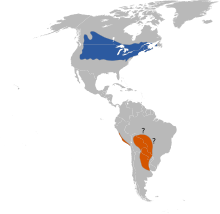
| |
| Approximate distribution. Breeding range Non-breeding range
| |
| Synonyms | |
| |
The bobolink (Dolichonyx oryzivorus) is a small New World blackbird and the only member of the genus Dolichonyx. An old name for this species is the "rice bird", from its tendency to feed on cultivated grains during winter and migration. The bobolink breeds in the summer in the United States and Canada, with most of the summer range in the northern U.S. Bobolinks winter in southern South America, primarily Paraguay, Argentina, and Bolivia. Bobolink populations are rapidly declining due to numerous factors, such as agricultural intensification and habitat loss; they are considered threatened in Canada, and are at risk throughout their range.
Etymology
[edit]The genus name Dolichonyx is from the Ancient Greek dolikhos, "long", and onux, "claw". The specific oryzivorus is from Latin oryza, "rice", and vorare, "to devour"; an old name for this species is "Rice Bird".[2] The English "Bobolink" is from Bob o' Lincoln, describing the call.[3]
Description
[edit]Measurements:[4]
- Length: 5.9–8.3 in (15–21 cm)
- Weight: 1.0–2.0 oz (28–57 g)
- Wingspan: 10.6 inches (27 cm)
Adults are 16–18 cm (6.3–7.1 in) long with short finch-like bills and weigh about 28 g (1 oz). Adult males are mostly black with creamy napes and white scapulars, lower backs, and rumps. Adult females are mostly light brown with black streaks on the back and flanks, and dark stripes on the head; their wings and tails are darker.

Distribution and movements
[edit]The bobolink breeds in the summer in North America across much of southern Canada and the northern United States;[5] from 1966 to 2015 the species experienced a greater than 1.5% annual population decrease throughout most of its breeding range, extending from the Midwestern United States to the Canadian Maritimes.[6] The bobolink migrates long distances, wintering in southern South America.[5] One bird was tracked migrating 12,000 mi (19,000 km) over the course of the year, often flying long distances up to 1,100 mi (1,800 km) in a single day, then stopping to recuperate for days or weeks.[7]
Bobolinks often migrate in flocks, feeding on cultivated grains and rice, which leads to them being considered a pest by farmers in some areas. Although bobolinks migrate long distances, they have rarely been sighted in Europe — like many vagrants from the Americas, the majority of records are from the British Isles.[8]
The species has been known in the southern United States as the "reedbird," or the "ricebird" from their consumption of large amounts of the grain from rice fields in South Carolina and the Gulf States during their southward migration in the fall.[9][10][11] One of the species' main migration routes is through Jamaica, where they are called "butter-birds" and at least historically were collected as food, having fattened up on the aforementioned rice.[10][11]
Bobolinks are the only species of land bird known to annually migrate through the Galápagos Islands, which are over 2,000 km from their primary migration route.[12] A bobolink was collected in the Galápagos Islands by Charles Darwin in 1835.[13] Bobolinks have been hypothesized to act as vectors for avian malaria-causing parasites arriving in the Islands.[14] Additionally, bobolinks in the Galápagos have been found with seeds from Drymaria cordata, a plant native to the Galápagos but highly invasive elsewhere, entangled in their feathers, potentially spreading them to the mainland.[12]
Behaviour
[edit]Breeding
[edit]Their breeding habitats are open grassy fields, especially hay fields, across North America. In high-quality habitats, males are often polygynous. Females lay five to six eggs in a cup-shaped nest, which is always situated on the ground and is usually well-hidden in dense vegetation. Both parents feed the young.
Feeding
[edit]Bobolinks forage on or near the ground and mainly eat seeds and insects. They are nicknamed the "armyworm bird" because of their predation on large numbers of armyworms,[15]: 453 including the true armyworm (Mythimna unipuncta) and the fall armyworm (Spodoptera frugiperda),[16] acting as a natural pest control.[15]: 453 In Florida, bobolinks feed most often on the Fall armyworm rather than the True armyworm, as the former is more common in the region.[16]
Calls
[edit]Males sing bright, bubbly songs in flight.
Status and conservation
[edit]During the 1800s the bobolink, like many birds, was slaughtered in large numbers for the meat trade.[17]: 41
The numbers of these birds are declining due to loss of habitat. Bobolinks are a species at risk in Nova Scotia,[18] and throughout Canada.[19] In Vermont, a 75% decline was noted between 1966 and 2007.[20] Originally, they were found in tallgrass prairie and other open areas with dense grass. Although hay fields are suitable nesting habitats, fields which are harvested early, or at multiple times, in a season may not allow sufficient time for young birds to fledge. Delaying hay harvests by just 1.5 weeks can improve bobolink survival by 20%.[18] This species increased in numbers when horses were the primary mode of transportation, requiring larger supplies of hay.
A 2021 study found that the reintroduction of American bison across the United States was detrimental to bobolink populations, with adult populations dropping as much as 62% and juvenile populations as much as 84%. This is presumed to be due to many new bison herds being managed more as livestock than wildlife, often kept in fenced pastures and protected from predation, which encourages overgrazing, trampling, and rapid multiplying. The study also found that lighter grazing by bison did not have the same harmful effects, demonstrating that the two species could likely coexist under the right circumstances.[21]
Media references
[edit]Emily Dickinson penned many poems about or mentioning the bird. Edgar Allan Poe mentions the bird in "Landor's Cottage". William Cullen Bryant wrote about the bob-o'-link in his poem "Robert of Lincoln."[22]
The bobolink is mentioned in the song "Evelina" by Harold Arlen and Yip Harburg, from the musical Bloomer Girl:[23]
Evelina, won't ya ever take a shine to that moon?
Evelina, ain't ya bothered by the Bobolink's tune?
The bird is also one of the many important ornithological references in the poem "Pale Fire" by the fictional poet John Shade, part of Vladimir Nabokov's novel of the same name.
Sophie Jewett ends her poem "An Exile's Garden" (1910) with a reference to a bobolink.[24]
The bobolink is also mentioned in the film The Mouse on the Moon in connection with the fictional European microstate of Grand Fenwick, where oddly the bird is apparently common.
The bobolink is also mentioned in the musical Camelot. Words by Alan Jay Lerner.
The bobolink is mentioned in the song, "The Wind," by Billy Bob Thornton, written by Warren Zevon.
Gallery
[edit]-
Male, New England, United States
-
Female, New England, United States
-
Males – Maine
-
Female – Maine
References
[edit]- ^ BirdLife International (2016). "Dolichonyx oryzivorus". IUCN Red List of Threatened Species. 2016: e.T22724367A94863313. doi:10.2305/IUCN.UK.2016-3.RLTS.T22724367A94863313.en. Retrieved 12 November 2021.
- ^ Jobling, James A. (2010). The Helm Dictionary of Scientific Bird Names. London, United Kingdom: Christopher Helm. pp. 138, 285. ISBN 978-1-4081-2501-4.
- ^ "Bobolink". Oxford English Dictionary (Online ed.). Oxford University Press. (Subscription or participating institution membership required.)
- ^ "Bobolink Identification, All About Birds, Cornell Lab of Ornithology". www.allaboutbirds.org. Archived from the original on 2020-09-27. Retrieved 2020-09-30.
- ^ a b "Bobolink – Dolichonyx oryzivorus – Overview". Encyclopedia of Life. Archived from the original on 18 December 2013. Retrieved 14 December 2013.
- ^ "Bobolink Dolichonyx oryzivorus BBS Trend Map, 1966 - 2015". USGS. U.S. Department of the Interior. Archived from the original on 2019-08-30. Retrieved 2020-12-15.
- ^ Page, Candace (1 April 2011). "Vermont scientists paint detailed picture of bobolink migration". Burlington Free Press. Gannett. Archived from the original on 14 December 2013. Retrieved 14 December 2013.
- ^ "Bobolink in Lincolnshire". BirdGuides. Warners Group Publications Plc. Archived from the original on 2022-01-26. Retrieved 2020-12-15.
- ^ New Jersey. Board of Agriculture (1892). State of New Jersey: Nineteenth Annual Report of the State Board of Agriculture, 1891–92. Trenton, NJ: New Jersey State Board of Agriculture. p. 156. Archived from the original on 7 January 2014. Retrieved 14 December 2013.
- ^ a b Chapman, Frank M., ed. (1909). Bird-lore: An Illustrated Bi-monthly Magazine Devoted to the Study and Protection of Birds. Vol. 11. Wright, Mabel Osgood; Dutcher, William. The Macmillan Company. pp. 372–376. Archived from the original on 7 January 2014. Retrieved 14 December 2013.
- ^ a b "Common Names for Bobolink (Dolchonyx oryzivorus)". Encyclopedia of Life. Archived from the original on 18 December 2013. Retrieved 14 December 2013.
- ^ a b Perlut, Noah G.; Renfrew, Rosalind (2016). "Stopover on Galapagos During Autumn Migration of Bobolinks (Dolichonyx oryzivorus)". The Wilson Journal of Ornithology. 128 (4): 935–938. doi:10.1676/15-195.1. S2CID 90886243.
- ^ Darwin, C. R. 1963. Darwin’s ornithological notes (Nora Barlow, Editor). Bulletin of the British Museum (Natural History), Historical Series 2:201–278.
- ^ Perlut, N. G.; Parker, P. G.; Renfrew, R. B.; Jaramillo, M. (2018). "Haemosporidian parasite community in migrating bobolinks on the Galapagos Islands". International Journal for Parasitology: Parasites and Wildlife. 7 (2): 204–206. doi:10.1016/j.ijppaw.2018.05.006. PMC 6032038. PMID 29988782.
- ^ a b Capinera, John (2020). Handbook of Vegetable Pests (2 ed.). London, UK; San Diego, Ca, US: Academic Press. pp. xv+799. ISBN 978-0-12-814488-6. OCLC 1152284558. ISBN 9780128144893.
- ^ a b Capinera, John L. (December 2018). "armyworm, Pseudaletia unipuncta (Haworth) (Insecta: Lepidoptera: Noctuidae)". University of Florida Entomology Department. Archived from the original on 2017-12-13.
- ^ Borlaug, Norman E. Mankind And Civilization At Another Crossroad (Speech). UN FAO (Food and Agriculture Organization of the United Nations). 7th McDougall Memorial Lecture.
- ^ a b "bw logo - Nova Scotia Federation of Agriculture". Archived from the original on 2015-07-17. Retrieved 2015-07-16.
- ^ Canada, Government of Canada, Environment. "Species Profile (Bobolink) - Species at Risk Public Registry". Archived from the original on 2015-07-17. Retrieved 2015-07-16.
{{cite web}}: CS1 maint: multiple names: authors list (link) - ^ Page, Candace (25 June 2010). "1,100 miles in a day". Burlington, Vermont: Burlington Free Press. pp. 1A.
- ^ Kaplan, Rachel; Rosamond, Kristen; Goded, Sandra; Soultan, Alaaeldin; Glass, Alex; Kim, Daniel; Arcilla, Nico (10 September 2021). "Bobolink (Dolichonyx oryzivorus) Declines Follow Bison (Bison bison) Reintroduction on Private Conservation Grasslands". Animals. 11 (9): 2661. doi:10.3390/ani11092661. PMC 8471021. PMID 34573626.
- ^ "747. Robert of Lincoln. William Cullen Bryant. 1909-14. English Poetry III: From Tennyson to Whitman. The Harvard Classics". www.bartleby.com. Archived from the original on 2020-02-05. Retrieved 2020-02-05.
- ^ Meyerson, Harold; Harburg, Ernest (1995). Who Put the Rainbow in the " Wizard of Oz? ": Yip Harburg, Lyricist - Harold Meyerson, Ernest Harburg - Google Books. University of Michigan Press. ISBN 0472083120. Archived from the original on 2022-01-26. Retrieved 2013-05-26.
- ^ Jewett, Sophie (1910). The poems of Sophie Jewett - Sophie Jewett - Google Boeken. Archived from the original on 2022-01-26. Retrieved 2013-05-26.
External links
[edit]- Smithsonian Migratory Bird Center: Bobolink Archived 2013-12-24 at the Wayback Machine
- Bobolink – Cornell Lab of Ornithology
- The Nature Conservancy's Grassland Birds: Bobolink
- Bobolink - Dolichonyx oryzivorus - USGS Patuxent Bird Identification InfoCenter
- "Bobolink media". Internet Bird Collection.
- Bobolink photo gallery at VIREO (Drexel University)
